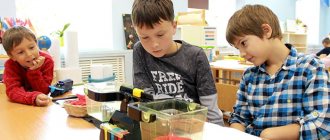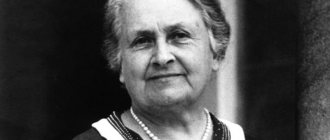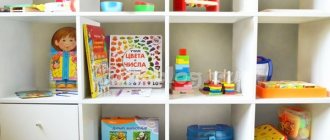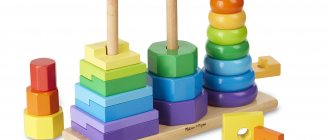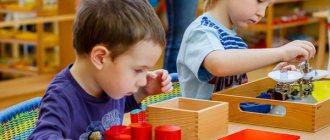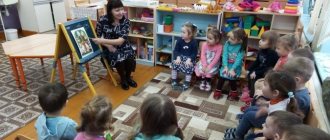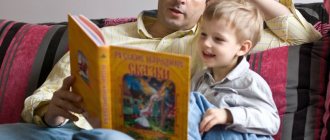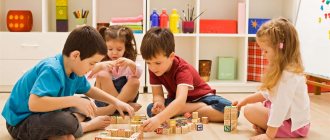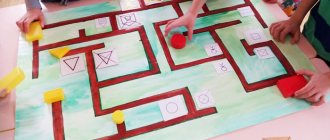The beginning of the twentieth century literally divided the history of mankind into before and after, because life underwent incredible changes and required new moral guidelines, approaches to education and upbringing, and the organization of work and leisure. It was a period of bold experiments and amazing discoveries. Despite all the social upheavals, people of the twentieth century became freer and more progressive, which means that upbringing and education had to change a lot, because kids had to grow up in a completely new world.
The observations and innovations of the Italian doctor Maria Montessori became a real breakthrough in pedagogy, since her approach simultaneously had both a good theoretical basis and brilliant results in practice. In this article we will try to highlight all the main features of Montessori education and discuss for which children classes using the M. Montessori method are best suited.
Basic Montessori Methods
To briefly outline the main ideas of the Maria Montessori method, it is important to first explain on what beliefs the approach is based:
1. The child develops following his natural interests and thanks to the experience independently gained on their basis,
2. Only a well-organized environment allows a child to fully realize his development potential,
3. An adult can be a guide and assistant, but cannot become the only full-fledged source of knowledge and skills for the development of a child,
It is these beliefs that determine the style of interaction between children and adults who have chosen the Montessori method for their children.
The approach is distinguished by a specially organized environment (didactic material freely accessible to the child), appropriate to the age of the children; the child’s leading position, his independence and free choice of activities; respectful and attentive attitude of adults to the individual needs of the baby.
Let's briefly formulate the basic principles of the Maria Montessori method:
1. Lack of a classroom system and free movement of the child in the classroom space,
2. The absence of a unified program and compulsory curriculum for all pupils, an individual approach to each child,
3. Classes using the M. Montessori method are held in a group of different ages,
4. Any Montessori session requires a prepared environment, ordered and varied materials for learning,
5. The adult follows the child’s interest, observes the children’s work and is very limited in their independent activities.
Now let's study in more detail the features of the Montessori method and start with what goals a Montessori teacher faces depending on the age of the students.
Brief biography of Maria Montessori
Maria Montessori was born on August 31, 1870 in Italy, in the city of Chiaravalle. Her father's name was Alessandro Montessori, who was an official in the Ministry of Finance and worked at a local tobacco factory. Her mother, Renille Stoppani, was well educated for her time. Maria was on very good terms with her parents. But the father did not agree with his daughter’s decision to get an education.
In 1875, Maria's father was transferred to Rome for work and took his family with him. There Maria entered the public primary school in 1876. Her early school years were "not particularly remarkable", but Maria was able to receive a first class diploma for good behavior and, in the following school year, for his success in "home economics".
Maria Montessori died at the age of 81 from a cerebral hemorrhage on May 6, 1952, in the Netherlands.
Goals of lessons using the Montessori method by age
The approach provides education for children from birth to secondary school, while the focus of attention, and therefore the techniques used in a Montessori environment, depend on the age of the child. Below we offer a table that outlines the main goals of Montessori education for children at different age stages.
| Child's age | Goals of Montessori education | Basic techniques and formats |
| From birth to three years |
|
|
| From three to six years |
|
|
| From six to twelve years |
| A comprehensive study of the experience accumulated by humanity and more specialized classes devoted to the study of the universe, wildlife, humanity, language and the world of exact sciences |
| Twelve to fifteen years old |
| Unfortunately, the methodology was not developed by Maria Montessori herself, however, followers of the approach actively use group work, scientific discussions, individual educational plans and practical work for the personal and professional development of adolescents |
Even from this table it is clear that the development of a harmonious personality must certainly begin at a very early age, which is why Montessori teaching methods are used primarily in preschool institutions, because in the future Montessori graduates are much more adaptive and achieve better results in schools of a variety of approaches.
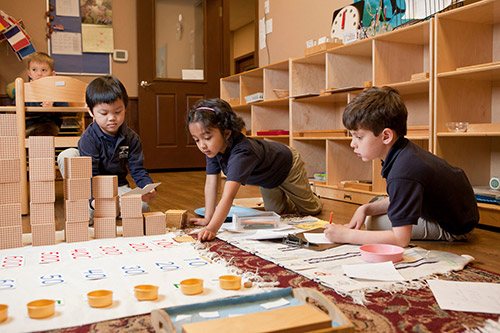
First of all, the essence of the Montessori method for children of all ages is education based on the individual strengths and interests of each child. Montessori education encourages children to explore the world around them and find their own place in this world.
Stages of development
Maria Montessori believed that as children grow older, they go through certain levels of development. To make learning as useful and enjoyable as possible, the lesson program must take into account the characteristics of each stage.
First level
- from birth to 6 years. The baby becomes an explorer who is already striving for independence. The adult acts as an observer and ally. He helps create a comfortable environment and learning environment, and then only supervises the learning process.
Second level
- from 6 to 12 years. The children experience physical changes: their baby teeth fall out, and their legs and torso grow evenly. A “herd instinct” and the desire to show oneself appear. Along with the body, imagination and intellect actively develop. At this stage, students need to be explained that it is normal to have their own opinion, even if it differs from the judgments of others. At the same time, children are told how to behave in society.
Third level
- from 12 to 18 years. It is associated with puberty and adolescence. This stage of development is the most unstable. Children's sense of justice and self-esteem intensifies. They are actively looking for their place in the world, are sensitive to their appearance and want to be liked. At this age, close attention is paid to the creative potential of a teenager.
Fourth level
- from 18 to 24 years old. Dr. Montessori believed that if a child is developed according to her method, then by the time he reaches adulthood he has already turned into a full-fledged personality with the makings of a leader. In general, she characterized this period as the need to receive money for her work. The young specialist strives for financial independence.
Montessori method - for which children is this approach suitable?
Surprisingly, we often meet parents who are convinced that Montessori teaching methods are only suitable for gifted and “naturally” motivated children. Parents feel that if their son or daughter is not forced to study, they will simply lie on the couch all day.
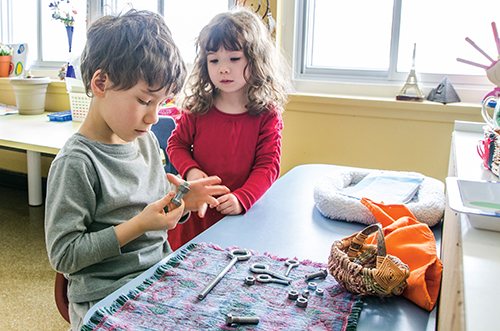
In fact, it is always worth remembering that children’s curiosity and desire to explore the world are an innate quality of absolutely any child. The described passivity is most often caused by external factors: an unsuitable environment and an incorrectly organized daily routine, incorrect behavior of adults, and poor health of the child.
Despite the fact that all Montessori techniques involve the child’s free choice and almost unlimited movement around the classroom, even the most “uncontrollable” and “difficult” children eventually successfully integrate into the process.
However, if you think that at first it will be difficult for your baby in group classes using the Montessori method or you are worried about some of the child’s health, all branches of our club offer individual lessons so that your baby has additional adult attention for easier adaptation to a new environment.
Principles of adapting a child to life
Let's start with a topic fundamental to the system. Scientific pedagogy considers upbringing as a process of adaptation of a child to human culture organized by an adult.
Some philosophical teachings about education are based on the fact that everything is in the genes, with which, by and large, nothing can be done. Others argue that a child is a blank slate on which an adult writes whatever he wants. These opposites have one thing in common: they deny the little person the importance of personal effort.
It is a mistake to view the process of growing up as something that happens due to external or internal causes beyond our control. The truth lies not between these extremes, but on a completely different plane.
Only the child himself can build his own personality, and only an adult can give everything that is needed for this construction.
Animals adapt through the processes of natural selection. The less the individual qualities of an organism are useful under environmental conditions, the greater the likelihood that it will not leave offspring similar to itself. Development depends directly on the environment, and not on the influence of other representatives of the species.
Caring for and training the offspring of animals with complex behavior is quite important. But still, the puppy grows up to be more or less a dog. Even if he is raised by people from childhood, or survives alone from an early age.
The strength of biological adaptation is that this way of growing up is difficult to break. The weak point is that the rigid program is suitable for a very limited range of conditions.
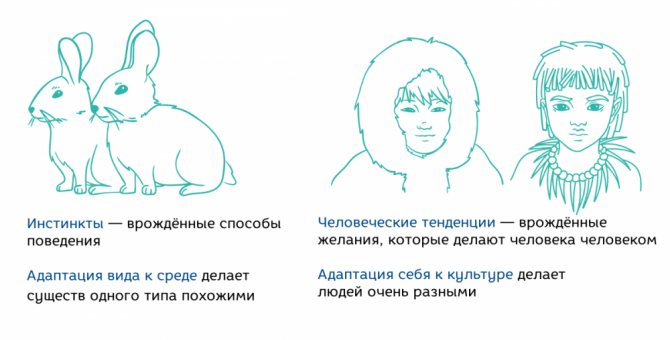
The principles of human adaptation are structured differently. A baby is born extremely immature and takes what it needs to grow up not from a rigid program of instinct, but from other people around him.
Children from different historical periods and cultures are not very different from each other. But having reached adulthood, each of them becomes a person of his time and place. We speak different languages, have different habits, are resilient and sensitive to different things. Not a single species on Earth is capable of living in such different conditions, eating such different foods, or surviving so differently in all climatic zones of the planet and even beyond its borders.
The child is recognized as the main character of his own development, and the adult is recognized as the main condition of this development, a model of culture, and a constructor of the space of growing up. Because he is able to consciously and creatively change both himself and the world around him, he is able to have a huge impact on how the child creates himself.
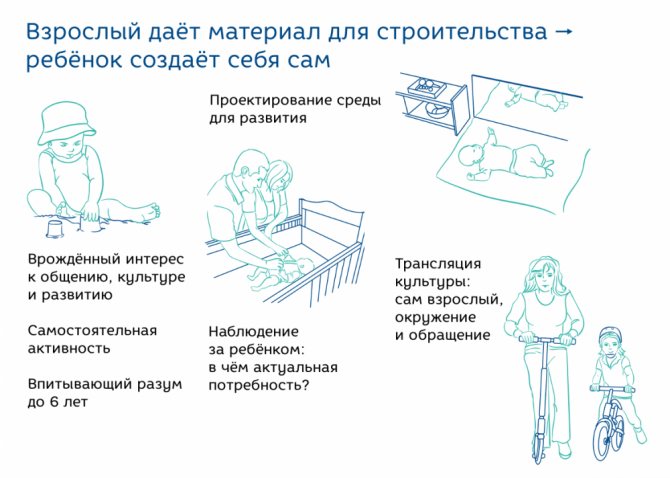
These principles define the essence of the Montessori method:
- Observing a child allows you to glean information from his behavior and interest about how best to help him.
- What is innate is not the result-instinct, but the interest in culture and development, called human tendencies.
- The concept of sensitive periods as an adaptation mechanism.
- A human difference in early childhood, which is called the absorbent mind.
- The importance of independence and own activity as a necessary condition for development.
The method answers in detail the question of what exactly an adult can offer a child, taking into account age and individuality. Such development conditions allow the best adaptation to their culture. And having matured, make your own contribution to the development of humanity.
Montessori kindergarten - what to expect from classes using the well-known method
The Montessori method is in demand both at school and in preschool institutions. However, in Moscow, most often, classes using the Maria Montessori method are designed for children up to 6-7 years old, after which they successfully transfer to both specialized Montessori schools and general education institutions. Taking into account this peculiarity of Moscow education, we have developed both a program exclusively based on the Montessori method, and groups where Montessori teaching methods and its basic principles are organically combined with more traditional formats of classes for children, as well as visits to a speech therapist and other specialists.
The environment of Montessori kindergartens stimulates children's cognitive activity. All Montessori classes are divided into zones: practical life, sensory, language, mathematics, space (the world around us), creativity. Each zone is filled with a variety of educational objects and didactic games, by interacting with which the child independently studies the properties and functions of things and learns new things.
In a Montessori kindergarten there is always a lot of space and educational materials, children always have the opportunity to choose an activity to their liking, and kindergarten teachers who have undergone special training in the Montessori method only help children make independent discoveries.
A pleasant bonus for parents who have chosen a kindergarten using the Montessori method will also be the availability of regular consultations for parents, at which teachers and child psychologists explain in detail the objectives of the method, share the successes of their students, and also give recommendations on education using the Montessori method. Houses.
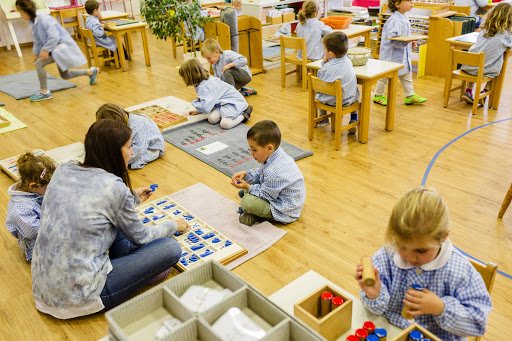
A little history...
The founder of the famous technique is the first woman in Italy to master the profession of a doctor. Working with children with developmental disabilities, the author developed her own rehabilitation course, which was highly appreciated in the teaching community.
In 1907, the “Children's Home” opened its doors for the first time for healthy preschoolers and schoolchildren. It was in this institution that the very methodology that we are talking about today was applied.
Subsequently, the method became widely known - Montessori gave a large number of lectures, published several unique books and many teaching aids. Preschool educational institutions appeared all over the world in which teachers used this method, and a little later experimental schools appeared. For more than a hundred years, it has remained at the peak of popularity among parents and teachers.
conclusions
Education according to the Maria Montessori method is qualitatively different from traditional approaches: an adult does not teach lessons and does not require them to put their hands on the desk and listen carefully, children have the opportunity and time to learn what is interesting to them, and a specially organized environment ensures that “interesting” “was always “useful.” Thanks to these conditions, the method has received international recognition, graduates of Montessori gardens consistently demonstrate interest in learning, developed self-control skills and successfully master the school curriculum, and parents are proud of their talented, independent and truly happy children.
Our opinion
The early education method of the Italian doctor and scientist Maria Montessori is quite interesting and original. Children raised in Montessori classes are independent and self-confident, able to solve everyday problems. They not only defend their opinions, but are also able to take responsibility for their own actions. If you have a desire to see these qualities in your child, try reading several books and manuals by the author: “Children’s Home”, “My Method”, “My Method. Guide to raising children from 3 to 6 years old”, “Help me do it myself”, “Montessori child eats everything and does not bite”, “Self-education and self-study in elementary school (collection)”, “Children are different”, “ Montessori Home School (8 Book Set)”, “The Absorbent Mind of a Child”, “After 6 months it’s too late. A unique method of early development” – and take note of some tips on child development and upbringing.
Next: DIY Montessori Method: Organizing a Developmental Environment at Home
Useful book - 60 activities with a child using the Montessori method
We also read about other popular methods of development and education:
- Early education methods
- Early development methods
Yulia shares from her experience the positive and negative aspects of the Montessori method:
Zoning of premises
According to the Montessori system, the following main zones are distinguished:
- Practice or real life . Here children will learn basic everyday skills. Cleaning and washing supplies, buttons and laces can be placed here.
- Perception or sensory . For children to be able to develop, all objects located in this zone must be of different shapes, weights, sizes and shades. You can use jars, boxes, etc. The baby will train fine motor skills and learn to distinguish things by tactile sensations. In addition, in this zone he will be able to train his memory and attention.
- Mathematicians . This zone promotes the development of abstract thinking, fosters perseverance and patience. Materials can be counting sticks, figures (squares, triangles, etc.).
- Language . Here children can learn to write and read, therefore in this area there should be various cubes with letters, copybooks and alphabet books.
- Space . As the name implies, this area is used so that the baby can get acquainted with the world around him. For example, with other countries, weather, animals, etc. In this area you can place animal figures, maps, books, etc.
This is the author’s version of zoning, but more modern variations of the technique involve the use of zones for physical development, music, art, dance, foreign languages, etc. But there is rarely enough space for them in average apartments. But such in-depth zoning comprehensively develops the child.
Real life zone
This zone is called practical, since its main task is to accustom the baby to the everyday side of life and instill hygiene habits.
Classes in this area help children master the following skills:
- how to take care of yourself (fold clothes, perform hygiene procedures, eat and even cook);
- how to care for the surrounding space (clean, water flowers, feed pets);
- how to move (walk quietly, in a straight line);
- how to create communications (communicate with parents, educators, peers, in society).
In the area under consideration, you can use materials such as:
- boards with buttons, straps, clasps, etc.;
- dishes of different shapes and sizes;
- indoor plants and cut flowers;
- broom and dustpan.
In principle, you can use any item that is used in everyday life. But the use of toys is undesirable - all things must be real. Although you should not forget about safety rules and such items as scissors, knives, etc. use only when the child begins to understand what danger this thing can bring and how to use it correctly.
Sensory area
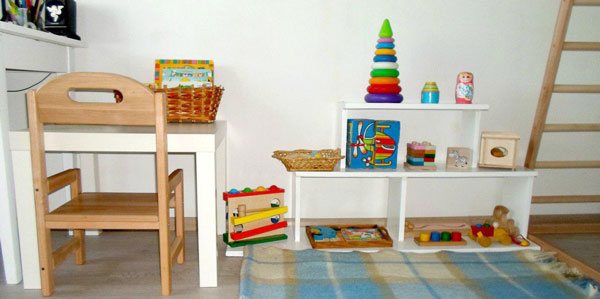
Helps improve:
- fine motor skills;
- vision;
- touch;
- hearing;
- baric feeling (feeling of weight).
To ensure that children can fully play in this area, the following items are used:
- multi-colored signs;
- nesting cylinders of different sizes;
- signs with rough and smooth surfaces;
- fabric scraps;
- bells;
- heavy and light objects;
- fragrant bags.
The main difficulty of equipping this zone is to emphasize all sensory senses without highlighting any one. Therefore, it is important to collect a variety of materials. Some will affect hearing, others - vision, others - smell, etc.
Math Zone
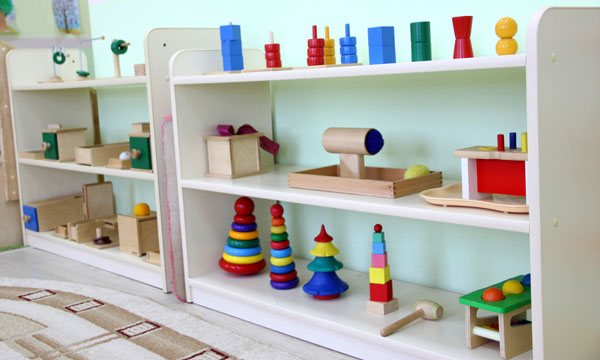
The areas of sensory and mathematics are interconnected. Comparing materials with each other, the child measures them by performing mathematical operations. The sensory zone only prepares the baby for numerical operations. In mathematics, children are already beginning to master mathematical concepts.
This will require special materials:
- numbers made of fabric (can be made of paper, but then the risk of tearing them is higher);
- cards with numbers;
- rulers;
- beads for mastering basic mathematical operations;
- circles divided into shares;
- geometric figures.
The main thing is that the materials are visual. It is easier for a child to remember a number if he can touch it or turn it in his hands.
Language zone
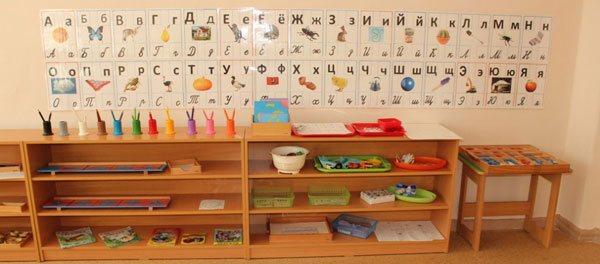
This zone is closely connected with the sensory zone and develops fine motor skills.
That is why almost all the equipment in it is aimed at developing sensory sensations:
- letters made of tactilely pleasant materials;
- inserts;
- movable alphabet;
- frames for shading;
- intuitive reading cards.
All these devices contribute to the correct formation of speech skills and their development. The materials expand children's vocabulary.
Space zone
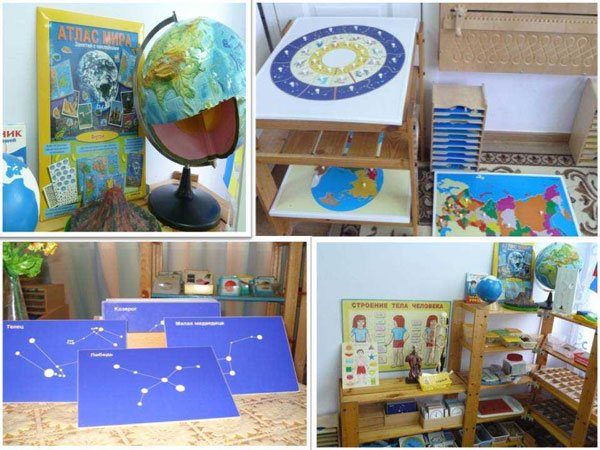
The second popular name for this zone is natural science education. Children here receive information about the environment, subject connections, learn historical facts and gain an understanding of biology, geography, natural history and other sciences.
So that the guys can gain as much knowledge as possible in this zone, you can leave the following equipment:
- encyclopedias and reference books (naturally, for children, with an abundance of colorful pictures);
- maps (geographical and natural);
- models (for example, solar system, mountains, volcanoes);
- materials on the typology of animals and plants;
- calendars;
- materials for experiments (something safe, such as potatoes and iodine to see starch);
- seeds and leaves of the plant.
In general, these can be any materials thanks to which the child can better get to know the world where he lives.
Teaching activity Maria Montessori
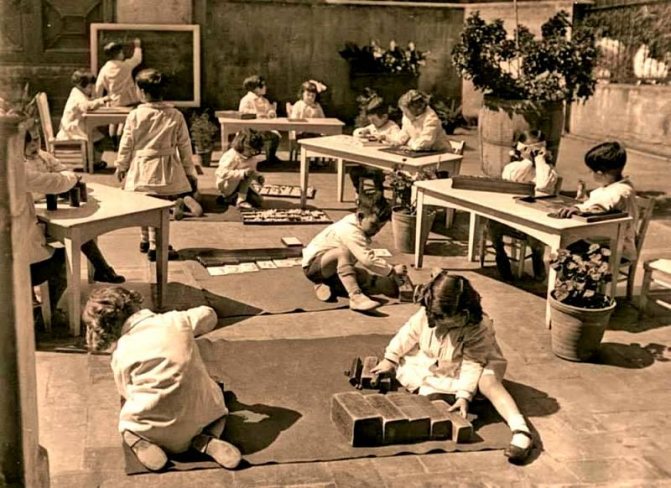
The concept of forming a child according to Montessori did not develop all at once. Under the influence of the founder of genetic psychology, Jean Piaget, and child psychologist Anna Freud, Maria clarifies the conclusions of her own research, according to which the correct formation of the child is accomplished. Using her own examples from her teaching practice, Maria confirms that an adult is not obliged to do something for a child, but is simply obliged to provide assistance to him, to act independently, while shaping the physical and personal development of the child. Because when a child is born and sees him detached and unadapted to his life.
Maria suggests that already at 2.5-3 years old, give the child the opportunity to try to do something on his own, for example, move a chair or put some objects on his shelves. These items can be: various dishes, toys, boxes, etc. Adults, in turn, only help him. Montessori suggests arranging objects in a specific, strict logic, and teaching children to maintain a certain order from the very beginning. Only this is not because adults want it this way, but because it is more convenient to shape the personal development of a child. Maria believes that a child will not always be able to implement order, but an adult can help him in creating circumstances in which order is simple and natural. An adult should teach a child only one clear rule: “Pick it up, work with it, put it back in its place.” But in order for the work to be productive in raising and shaping a child, an adult must give a short lesson that lasts 2-3 minutes, no more. In this lesson, the adult must demonstrate how to handle objects in order to achieve results, and not become discouraged and lose interest.
Maria Montessori urges parents not to accelerate the mental and physical development of their children, but also not to miss the moment and help him in time.
So leave unnecessary disputes, or Debunking myths about the Montessori system
In recent years, we have often been involved in debates about the Montessori system. On the one hand in these disputes are its adherents, people who already have some experience in this system, who work as teachers or even created their own private kindergartens and schools, who attended kindergartens and Montessori schools in different cities and even who specially traveled to European countries for this purpose. USA, some have received expensive international education in the field of Montessori methods.
On the other side of the debate are either persons completely unrelated to education, or quite experienced Russian specialists in traditional education - from a school teacher and tutor to the dean of the psychological faculty of a pedagogical university. But they are familiar with the system from quotes from pedagogy textbooks, from retellings of university teachers. And what’s interesting is that they all necessarily speak AGAINST the Montessori system and put forward the same set of arguments, regardless of their experience.
In general, the presence of a set of standard arguments “against”, a method common to such opposing categories of opponents, causes a certain concern and leads to some conclusions. But we will return to these conclusions later. Now let's look at these arguments in more detail.
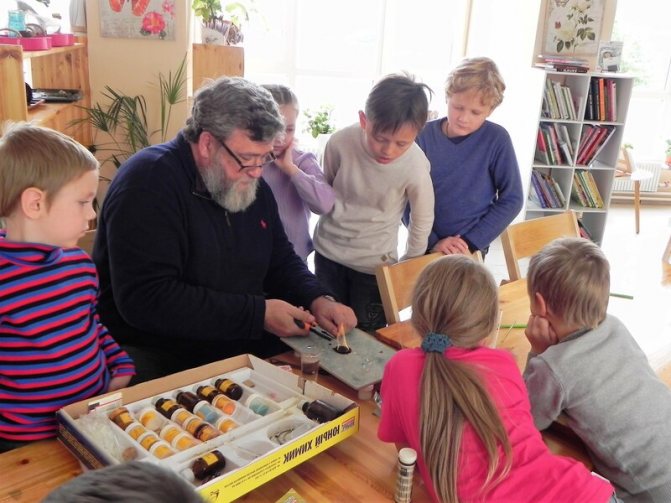
Maria Montessori worked with children with mental retardation, and her system was designed specifically for such children
Montessori’s opponents who make this argument seem to be saying to parents of normal children who are interested in the Montessori method: “This system was developed for mentally retarded children. Are you saying that your children are mentally retarded? This system is not for you!
Yes, indeed, since 1896, as a doctor, she observed mentally retarded children in a university clinic, and from 1900 to 1904 Maria Montessori was the director of a school for mentally retarded children, and it was during this period that she had a desire to take a closer look at the problems development and education of children.
Montessori listened to lectures on psychology and pedagogy, deeply studied the works of outstanding psychologists Seguin and Itard, translated a number of books on correctional psychology into Italian, and decided on the general direction of her large-scale scientific, pedagogical, and organizational activities, which lasted until 1951. Since 1906, Maria Montessori began to create educational institutions for healthy, ordinary children. But, of course, the Montessori pedagogical system developed much later.
It developed in the 1950s, 60s and 70s. The Montessori pedagogical system continues to develop today. Therefore, claims that the system is intended for mentally retarded children are lies, if not deliberate misinformation about this pedagogical system.
Yes, even if the Montessori system had really been developed only for children with developmental delays, do we know many examples when discoveries and inventions are used for purposes other than their original purpose?
I immediately remember the invention of the semiconductor transistor (for which the Nobel Prize was later awarded), the scope of which, according to its inventors, was hearing aids for people with hearing impairments. Interestingly, bed pillows were originally invented to prevent insects from crawling into the ears, nose and mouth of a sleeper (and to maintain his hair), Coca-Cola as a treatment for morphine addicts, jeans as work clothes for cattlemen, and corn cereal as a meat replacement food to prevent masturbation!
But the most amazing thing is how can such an argument be used AGAINST the Montessori system? It would seem that since Montessori approaches were developed for mentally retarded children and gave good results, it means that these are very effective methods that will work even more successfully on completely normal children! However, in Russia, despite the current interest in inclusive education, there is a purely philistine tradition of viewing a person (or child) with disabilities as an infectious patient, from whom one must stay as far away as possible so that mental retardation does not “spread” to normal children!
Montessori gave birth to an illegitimate son and sent him to be raised in a boarding school
Yes, indeed, in 1898, at the age of 28, Maria Montessori gave birth to a son from a colleague at the university clinic, Giuseppe Montessano, who later became a prominent psychiatrist. However, Montessano’s mother did not give permission for the marriage; as a result, the child was born illegitimate; Maria Montessori was not ready to completely abandon the scientific work she had begun and her emerging career and devote herself entirely to the child. Until the age of 10, Mario’s son was raised, not in a boarding school, but in a family of distant relatives, in the countryside, where his mother visited him on weekends. When her son turned 10 years old, she took him and practically never parted with him until the end of her days.
Needless to say that such a family situation, due to patriarchal morality and the practice of double standards in relation to men and women, was quite typical in those years? There are many known families where children were given “to be raised” by grandmothers or other relatives, or where a woman was forced to hide the fact of marriage or the presence of children in order to occupy one or another government position. So, for example, not so long ago the elderly and very famous actor Jack Nicholson suddenly found out that the one whom he considered his mother all his life was his grandmother, and his real mother was the woman whom he considered his sister, who gave birth to him at a very young age and outside of marriage.
An argument against the Montessori system on the basis of its difficult family circumstances is one of the characteristic philistine methods of criticism, based on the patriarchal morality of a backward society, and reducing the content of major philosophical and scientific achievements to bed and family stories from the lives of outstanding scientists and thinkers.
But maybe let's continue about the relationship between Mario's son and Maria Montessori? He became her closest comrade-in-arms and associate, and in fact, it was he who gave the Montessori system the look it has today, especially in terms of school education, that is, Mario’s contribution to the development of the Montessori system is very great and underestimated. Later, the system was also developed by grandson Mario and granddaughter Renilda Montessori - so this is truly a family enterprise, and the name Montessori does not entirely refer to the founder of the system, Maria Montessori.
Let us ask ourselves again, why is the situation with a hidden illegitimate son used as an argument against the Montessori system? Apparently, the point here is to “play” on hidden, unconscious patriarchal and vulgar moral attitudes, characteristic of the average person, about the place and role of women in the family and society.
Montessori was friends with Mussolini
It is useful to make historical inquiries and find out at least the basic facts of Mussolini’s biography and the history of Italy in the first half of the 20th century. Benito Mussolini, who came from the family of a rural blacksmith and had a difficult education, began his career as a primary school teacher and activist in the socialist movement in Italy. It is interesting that Mussolini was familiar with V.I. Lenin, and met him in Switzerland. Since 1909, Musolini engaged exclusively in political journalism in Bolshevik-socialist publications, but in 1918, after the First World War, having experienced disappointment in socialism, he broke with the socialists and began to develop the ideology of fascism, build a fascist party, preaching the need for a strong and decisive hand to guide order in Italy, synthesizing nationalist, racist, religious and statist views in a totalitarian spirit. Mussolini quickly attracted the attention and love of the aristocracy and ordinary people. The cult of Mussolini as a national leader gradually formed.
In 1922, Mussolini led Italy as prime minister. At the same time, contacts between Mussolini and Montessori took place, and Maria Montessori was appointed state inspector of schools in Italy. During these years, Maria Montessori travels and speaks a lot (especially in the USA), popularizing her pedagogical methods, founds public organizations to implement her pedagogical methods in different countries, founded the AMI (in 1929), and teaches courses for teacher followers. Thus, at one time, a Montessori school operated in the basement of the White House, run by President Wilson’s wife.
Montessori refused to cooperate with Mussolini's government. She did not see eye to eye with B. Mussolini, who believed that the school should educate ideal citizens, soldiers for their state. Let us note that during this period Mussolini became one of the first leaders of European countries who recognized Soviet Russia; he was considered one of the best students of V.I. Lenin and L.D. Trotsky. Until 1936, when Italy supported General Franco in the Spanish Civil War, Mussolini was considered a great friend of the USSR. M. Gorky, for example, at that time lived and worked in Italy, and other “Soviet” writers visited him.
In 1934, Montessori’s conflict with the Italian government escalated so much that she had to literally flee the country from the Nazis (to Spain, Barcelona), and then, after the Franco victory in the Spanish Civil War, to the Netherlands, then, after Germany captured the Netherlands, to India, where Montessori and her son had to hide in a Russian spiritual mission from the British, who wanted to intern her (place her in a concentration camp) as a native of an enemy country (Italy).
So there is no direct connection between Montessori and Mussolini, and there is no point in trying to denigrate the Montessori pedagogical system using the extremely confusing history of the 20th century, the characteristics of its figures, which became clear much later, based on the results of their activities. And, moreover, it is far from final, judging by the attempts to glorify some of them.
And the attempt to use history in order to evaluate the Montessori system without trying to understand its essence, only on the basis of a historical background, smacks of labeling, the use of ideological horror stories from the times of Suslov and party commissions, and extreme professional incompetence.
There are no examples of Montessori school graduates who have achieved outstanding success
Well, this is how to say it, and what is considered success. Firstly, in its current form, Montessori schools have not existed for very long, some 50-60 years, and secondly, they remain not such a widespread phenomenon; such schools are actively created only after the 1990-2000s.
They are most widespread (attention!) in the USA and the Netherlands (there they are 40% and 30%, respectively), in the most socially and technologically developed countries of the Western world. Of course, there are Montessori schools in other European countries - Great Britain, Germany, France, Spain. In Italy, for example, there are few Montessori schools (about 130 in total), but this is due to the fact that the principles of the Montessori system have “dissolved” in national education.
And at the same time, it must be borne in mind that Montessori schools are small schools in terms of the number of students and, moreover, limited to the so-called elementary level of education, that is, the education of 6-12 year old children. There are only a few full-cycle schools up to 18 years of age in the world. Interest in them is very great, so we can expect a massive emergence of such schools in the near future.
And yet, secondly, despite the fact that Montessori schools are a relatively new and small (in terms of the number of students) phenomenon, there are outstanding graduates of Montessori schools!
This is practically the first thing I found on the Internet:
Gabriel Garcia Marquez, Nobel Prize winner in literature Prince William and Prince Harry, members of the English royal family Peter Drucker, publisher, management guru Sergey Brin, Google co-founder Jeffrey Bezos, Amazon.com founder Jimmy Wales, Wikipedia founder Katherine Graham, owner/editor Washington Post Jacqueline Bouvier Kennedy Onassis, editor, former First Lady (the same wife of President John F. Kennedy, who was assassinated in Dallas) Sean Coombs, music magnate Anne Frank, author of The Diary of Anne Frank Will Wright, co-founder and designer of The Sims Helen Hunt, Academy Award-winning actress George Clooney, Academy Award-winning actor Joshua Bell, American violinist and Stradivarius winner Berry Brezelton, distinguished pediatrician Julia Child, chef, cookbook author, TV star Friendensreich Gundertwasser, Austrian artist, architect Kemi Kotler, actress (youngest child of the long-running series The Waltons) Dakota Fanning, actress Melissa and Sarah Gilbert, actresses Lee Selonga, Filipino-American actress, Broadway actress.
What, not impressive? We don’t even know who they are, what merits they have and what awards they have received? Well, with the exception of Marquez and the princes from Great Britain.
This can be explained simply: here in Russia we are a remote province, a distant periphery, where the noise of modern world cultural life practically does not reach; we cannot even judge the scale of the talent of its figures! Maybe only decades later. And in the USA, these people are on everyone’s lips, they are recognized stars, arousing universal admiration and envy.
That is, this model for evaluating the education system, based on its eminent graduates, does not really work.
Let's take another aspect.
The current education system - inherited from the USSR - did not develop overnight. Immediately after the revolution, from 1918 until 1931, there was no single school model in Russia. There was a wide variety of their types - Frenet school, Dewey school, FZU, Makarenko school, etc. There were also several kindergartens based on the Montessori system, opened by Montessori follower Julia Fausek and others.
However, in 1931, by decrees of the People's Commissariat of Education, all this diversity was stopped, and we moved to a single school, which was supposed to provide mass training of qualified workers and engineers for the national economy. Based on a class-lesson system and a centrally approved training program.
By the way, the basic, class-lesson principle of classical education, that children should sit at rows of standing desks and, as one, listen to the teacher and do at the same time what he says, was invented by the Czech Jan Komensky at the beginning of the 17th century. Then, at the beginning of the 19th century, another outstanding teacher, the German von Herbart, came up with the idea that the teacher should not say what he wants, but teach according to a pre-compiled and approved program. Since then, albeit in a somewhat blurred form, we have a traditional Russian school of exactly this type, established in 1931 and finally established by 1940.
However, the success or failure of the national education system manifests itself after about 20-30 years, if education is judged by the activities of graduates of this system, when these former graduates acquired decisive weight in society and took command posts, so to speak, they stood “at the helm.” This usually occurs in specialists aged 40-50 years. The most dynamic scientific and technological development in the USSR occurred in the 1950s-60s, it was then that our atomic weapons were created, peaceful atoms were mastered, rockets were developed and the first flights into space were made. Now let's count back 20-30 years and see what happens. It turns out that the main contribution to the technological breakthrough of the USSR was made by children from the years 1920-1940, that is, those years when there was a wide variety of types of schools, the project method of teaching, laboratory school, labor school, etc. were used. Those children who studied after the war within the framework of the classical “Soviet school” - they turned out to be “figures” of the era of stagnation, when progress in the USSR stalled, crisis phenomena began to grow and, in the end, the USSR collapsed.
Several other considerations can also be given. Crime has always been very high in Russia, almost 10% of the population served time under criminal charges. Let's ask ourselves, isn't the traditional Russian education system responsible for a significant share of this? And is she not responsible for the high level of teenage and child suicide? As a conclusion: we need to talk not about what successes specific graduates of Montessori schools achieve, but what damage the existence of a single, non-alternative traditional type of school, based on totalitarian values, subordination, lack of choice and conscious collective activity of children, causes to the country and society. The delay in meaningful systemic school reforms, in particular the slow development of Montessori schools, will ultimately result in another stagnation and scientific and technological backwardness of the country.
Education in Montessori schools is not free. This is siphoning money from parents
Yes, indeed, education at a Montessori school cannot be free. Such a school cannot be a “state” school; we have only one type of public school, approved by I.V. Stalin in the 1930s - with the class-lesson system of Jan Komensky and the curriculum invented by von Herbart.
And in a class according to the Montessori system there should be about 25 children, and in area it requires about 100 m2 - this is twice as much as a regular school class, in which 35-40 people are seated. In addition, the classroom space - the studio should not be such a barn, as is the case in many public schools. The studio should have a lot of light, good repairs, natural furniture, not chipboard - and renting real estate, utilities and good furniture is not cheap these days.
Particularly important in a Montessori studio are the materials and the environment, which at current prices cost no less than 1 million rubles, or even more, and this environment needs to be constantly supplemented and modernized. Children and the teacher should not experience any restrictions regarding consumables - different types of paper, pencils, markers, scissors, etc.
But most importantly, Montessori teachers. This is a rare and expensive category of workers. They need to be constantly searched for, selected, attracted, retained, and measures taken to consolidate them. Not every teacher can be a Montessori teacher! As a rule, a teacher, even with little experience in working in a “public” school, can no longer become a Montessori teacher, because there teachers quickly learn to yell at children, “build” them and command them, give marks, instead of interest them. In short, “teach” the child, “give knowledge,” instead of helping the child learn independently in working with the material, develop the child’s human potential.
Montessori teachers must receive a decent salary not lower than the regional average, constantly improve their qualifications, study, and develop professionally. Thus, the cost of generally recognized international Montessori methods courses by AMI is no less than 10,000 euros, and taking into account the fact that you need to go abroad, live and eat there, the cost of training one teacher is about 2 million rubles. The Russian education system does not produce such specialists.
But it’s not even about the school’s high educational expenses. The population of Russia has not yet realized the meaning of the saying that free cheese can only be found in a mousetrap, and they experience a painful craving for all sorts of freebies.
For some reason, people believe that they can provide education to children for free, and this education can be of high quality. But he will be severely disappointed.
From the very first days, parents who sent their children to public school will be faced with the fact that public public education is of poor quality, even if it gives some knowledge, but very often it simply cripples the child’s personality, kills interest in knowledge, hard work, desire and ability to joint activities with other children, cooperation. Our public school is the lower level of education, semi-free for citizens and, at the same time, an object of constant savings for the state. Public school is designed to guarantee access to education for the poorest sections of the population.
Now, slowly, but the idea of free apartments and symbolic rent is being eradicated. People are already accustomed to the fact that it is better not to go to a “state” free dentist - it will be very painful and of poor quality. Now we are eliminating free state healthcare. And next in line is education.
Unfortunately, in the minds of the average modern parent, expenses, expenses for a child, for his education, do not have priority in family expenses and are done on a residual basis. Russians do not yet have the idea that the main function of any adult and family is to raise and educate children. We, adults in Russia, still have no idea why we are needed and why we exist. It is believed that you need to live “properly” yourself. Therefore, we consume uncontrollably, travel abroad, buy cars, go to restaurants - but spending on children’s education is not for us, the state should provide education and upbringing to children!
But, for example, in America, a good education for children in a high-quality, prestigious college or university (and, of course, at the very beginning, in a private Montessori school) is a priority. When a young guy and girl get married, they immediately decide which prestigious school and college they will send their future children to, and begin to save money for this!
It is necessary to understand that education in a general, state school does not lead anywhere; it is a government-run and low-quality education for poor and passive people, whose destiny is to obey. And that you need to worry not only about knowledge and grades, but also about the development of your children, intellectual, moral, ethical, aesthetic, which are important parts of the best education, and that this is almost impossible in a regular public school.
The Montessori school also gives the child productive life strategies that will ensure his future success in life, and not just the skills to “be like everyone else” and “obey what they say.” Such a school not only teaches, but also educates children in the spirit of the 21st century. Parents bear their part of the responsibility for raising their children - with money.
Therefore, the argument about paying for training using the Montessori method also, by and large, does not work against the Montessori system. The cost of such dough training is associated with its serious advantages, with the fact that it opens up new horizons and new opportunities for Montessori school students that meet the requirements of the 21st century. And here we need to clearly distinguish what we want: either high quality or cheap. High quality cannot be cheap! A Montessori school focuses primarily on the quality of education and upbringing.
Of course, a Montessori school is not for everyone. It cannot be general and easily accessible. And in the country as a whole and in each specific city, there should be schools of different types, using DIFFERENT pedagogical systems, not to mention different teaching aids and materials in accordance with the specific requests and needs of children and their parents, in accordance with the social group, interests, lifestyle, etc. Well, why did many people decide that the school should be the same and uniform, both in every city and town, and throughout the country? Why do some people think that this could somehow affect the integrity of our state? Of course it will! And it will have a negative impact.
In the USSR there was a free and general school for everyone, a single curriculum and textbooks. And what? The USSR collapsed. Moreover, the unity and lack of alternatives to the education system was one of the factors that contributed to the collapse of the country and the emergence of separate states with their specific education systems! But in Holland, “diversity in education” does not in any way interfere with the strength of the state. There are 9 different types of schools there, and Montessori school is one of them, and not the most numerous!
It remains to draw conclusions about the “arguments” against the Montessori system and those “specialists” (and non-specialists) who repeat these arguments again and again.
As we have already seen, these are not even arguments, but an attempt to express a protest, one’s conservative position in relation to everything new. This is a very superficial expression of a deep-seated reluctance to see the real problems of society (and education) and meaningfully solve them.
Really change education, starting from its very deepest foundations, and not just simulate changes - driving one or two academic hours a week back and forth between subjects. Or changing the textbook. Or introducing an educational form. Or offering to dance in physical education lessons.
The arguments of both specialists and laymen are the same, because, unfortunately, they are not far from each other in terms of their horizons and knowledge of pedagogy and psychology. I don’t want to offend anyone, but I have to state the sad fact that the level of psychological and pedagogical training of our teachers in general is extremely low, and the quality of education provided in the pedagogical areas of Russian universities is also extremely low. This level is low in comparison with the level of pedagogical training in foreign (European and American) universities.
Our Russian pedagogy, unfortunately, after those very educational reforms carried out by Krupskaya under the control of Stalin in the early 1930s, turned into one of the sections of Marxist-Leninist social sciences such as “History of the CPSU” or “Scientific Communism”, where much was determined by ideological party requests. Artificial and practically insurmountable barriers were erected between Russian pedagogical thought and the development of pedagogical theories and practices in the rest of the world, and many results of pedagogical research abroad, especially in the USA, turned out to be taboo and were prohibited. Even mentions of them were censored.
For example, a large-scale study led by B. Bloom on a taxonomy of pedagogical goals. This study, in which thousands of teachers and students took part, revealed that there are 6 levels in the taxonomy of pedagogical goals, and at the very top is the level of critical assessment, that is, when the student begins to think critically, evaluate and put forward evaluation criteria, argue and prove his opinion . Naturally, this was prohibited and persecuted in the USSR, because we had one helmsman - the CPSU party - and he himself assessed and argued everything, and the rest of the population should have been only executors of the highest will.
Only in recent years have the results of Bloom's research begun to be studied by Master's students in pedagogy, but it was conducted in 1956! And we’re not just talking about a lag of more than half a century! There remain many “blank spots” in Russian pedagogy, which have long been eliminated by relevant foreign research, and are obvious things to foreign teachers, but our teachers simply don’t know anything about it!
Much, very much in Russian pedagogy was determined by the tastes of party leaders and the demands of class and ideological struggle, and not by scientific research methods. Therefore, both Russian teachers, even with serious experience, and complete laymen differ little in their level of pedagogical knowledge and scientific culture. And when grandparents, remembering their childhood during the Soviet era, begin to judge the correctness or incorrectness of the ongoing reforms in education and put forward maxims about what a school should be like, they find themselves completely at the level of “advanced” Russian pedagogical thought.
It was through the efforts of Krupskaya that in 1926 the use of the Montessori method in kindergartens was prohibited for ideological reasons.
The resolution of the State Academic Council stated: “The negative attitude of Soviet teachers towards the Montessori system until recently was determined almost exclusively by the ideological content of this system (vitalism, mysticism, Christian socialism, etc.). Meanwhile, in addition to the completely unacceptable ideological side, the Montessori system also suffers from gross defects in the field of its biological and theoretical material. A number of misconceptions about the biological content of children's age-related evolution, underestimation of the biological significance of play and imagination, distortions in the understanding of the motor factor, underestimation of the importance of general processes in comparison with special skills - all these flaws exclude the possibility of using Montessori's biological theory as the pedagogical basis of Soviet preschool pedagogy... »
Here is another quote from Krupskaya’s article: “...Montessori kindergartens are thoroughly imbued with the spirit of bourgeois patriotism, they contribute entirely to the education of the younger generation in the direction dictated by the power of the landowners and capitalists of their country.”
If you look at textbooks on pedagogy for universities, published from 1930 until very recently, almost all of them contain these “arguments” against the Montessori system, copied by different authors from each other.
This is natural, because Montessori pedagogy is a fundamentally different, scientific level of pedagogy, considering the development of children in accordance with the general picture of the development of mankind and the long-term needs of society, and not as the requirements of the dictatorship of the proletariat
Let us note that at present the Montessori system is a powerful pedagogical system, developed not only by representatives of the Montessori family, but also by several generations of teacher-scientists and practitioners from different countries, and to judge this system only on the basis of quotes from N.K. Krupskaya in the 1920s , according to Soviet pedagogy textbooks, how to put it mildly, is incorrect.
Director of the Montessori school "Alice" (Voronezh), Doctor of Pedagogical Sciences, Professor A.V. Mogilev
